Abstract
OBJECTIVE: To determine the individual, physical, and psychosocial risk factors for carpal tunnel syndrome in a general population. METHODS: Population based case-control study in Marshfield epidemiological study area in Wisconsin, USA. Cases were men and women aged 18-69 with newly diagnosed carpal tunnel syndrome (n = 206 (83.1%) of 248 eligible). Controls were a random sample of residents of the study area who had no history of diagnosed carpal tunnel syndrome (n = 211 (81.5%) of 259 eligible). Cases and controls were matched by age. Telephone interviews and reviews of medical records obtained height and weight, medical history, average daily hours of exposure to selected physical and organisational work factors, and self ratings on psychosocial work scales. RESULTS: In the final logistic regression model, five work and three non-work variables were associated with risk of carpal tunnel syndrome, after adjusting for age. For each one unit of increase in body mass index (kg/m2), risk increased 8% (odds ratio (OR) 1.08; 95% confidence interval (95% CI) 1.03 to 1.14). Having a previous musculoskeletal condition was positively associated with carpal tunnel syndrome (OR 2.54; 95% CI 1.03 to 6.23). People reporting the least influence at work had 2.86 times the risk (95% CI, 1.10 to 7.14) than those with the most influence at work. CONCLUSIONS: Carpal tunnel syndrome is a work related disease, although some important measures of occupational exposure, including keyboard use, were not risk factors in this general population study. The mechanism whereby a weight gain of about six pounds increases the risk of disease 8% requires explanation.
Full text
PDF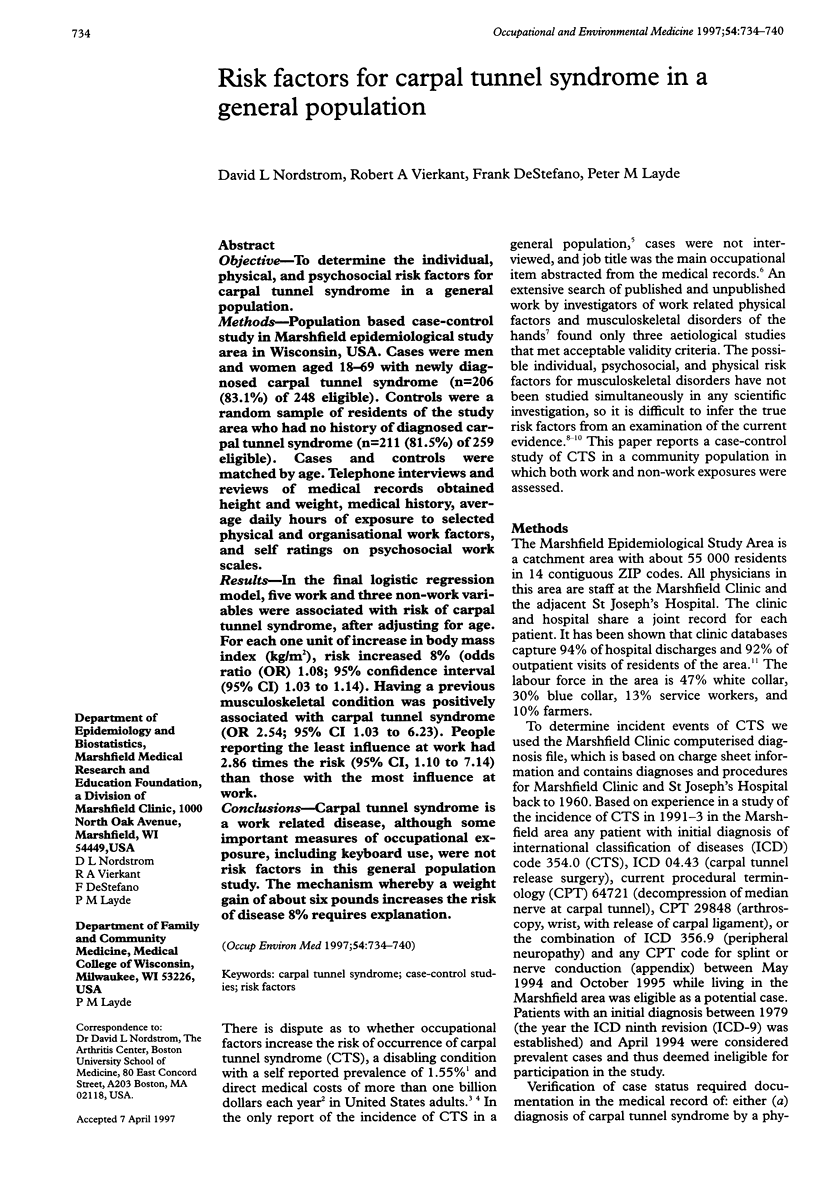
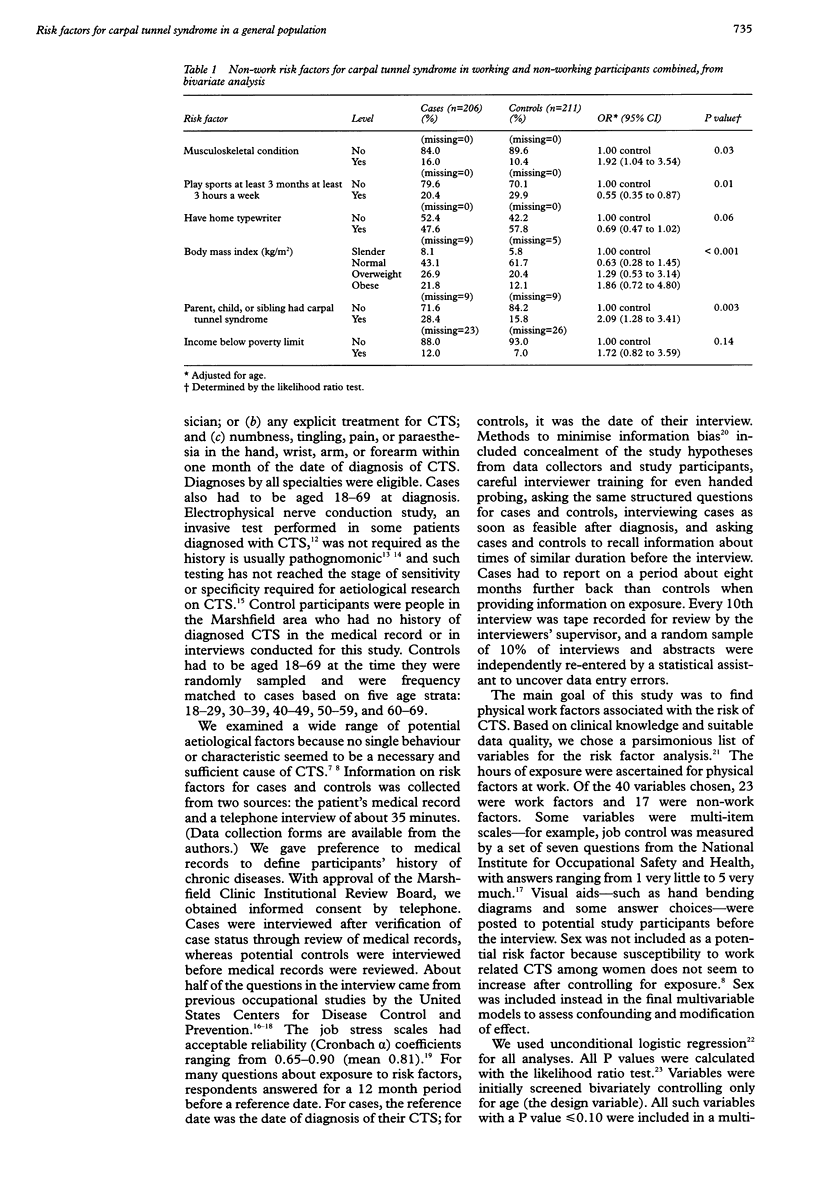
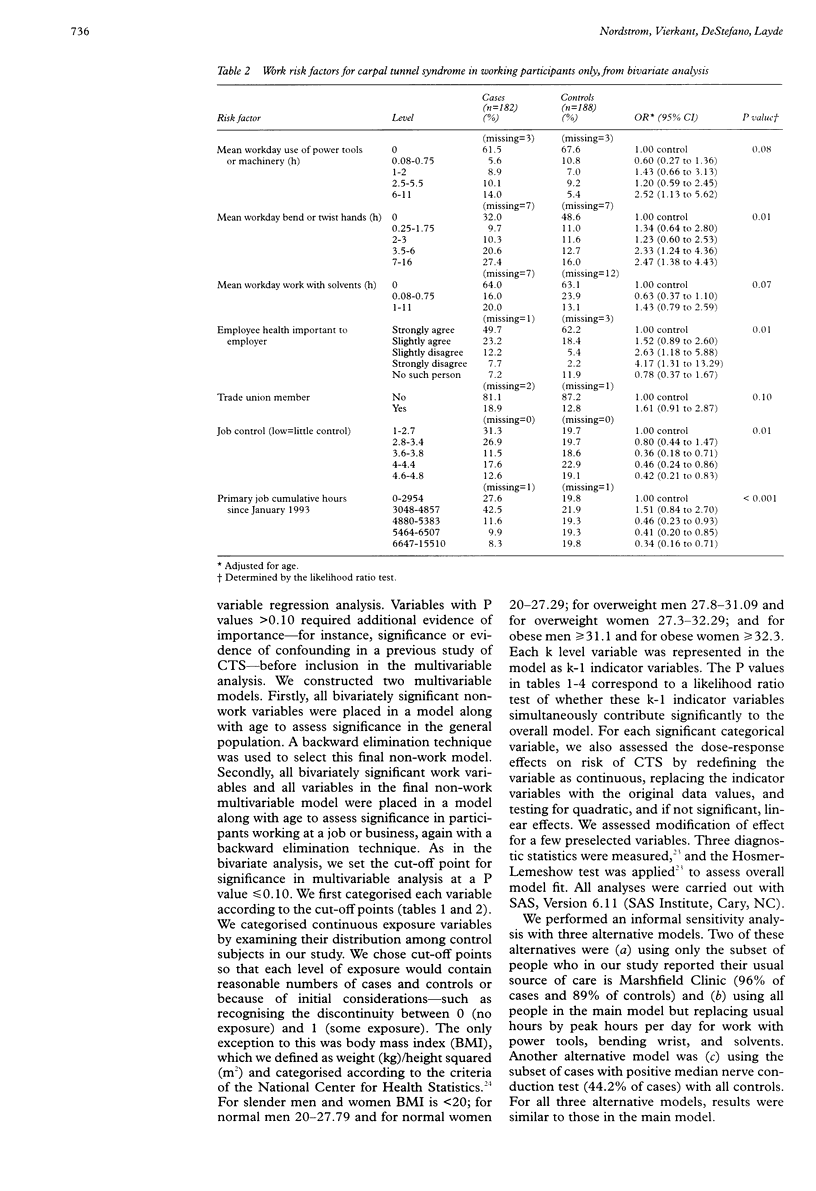
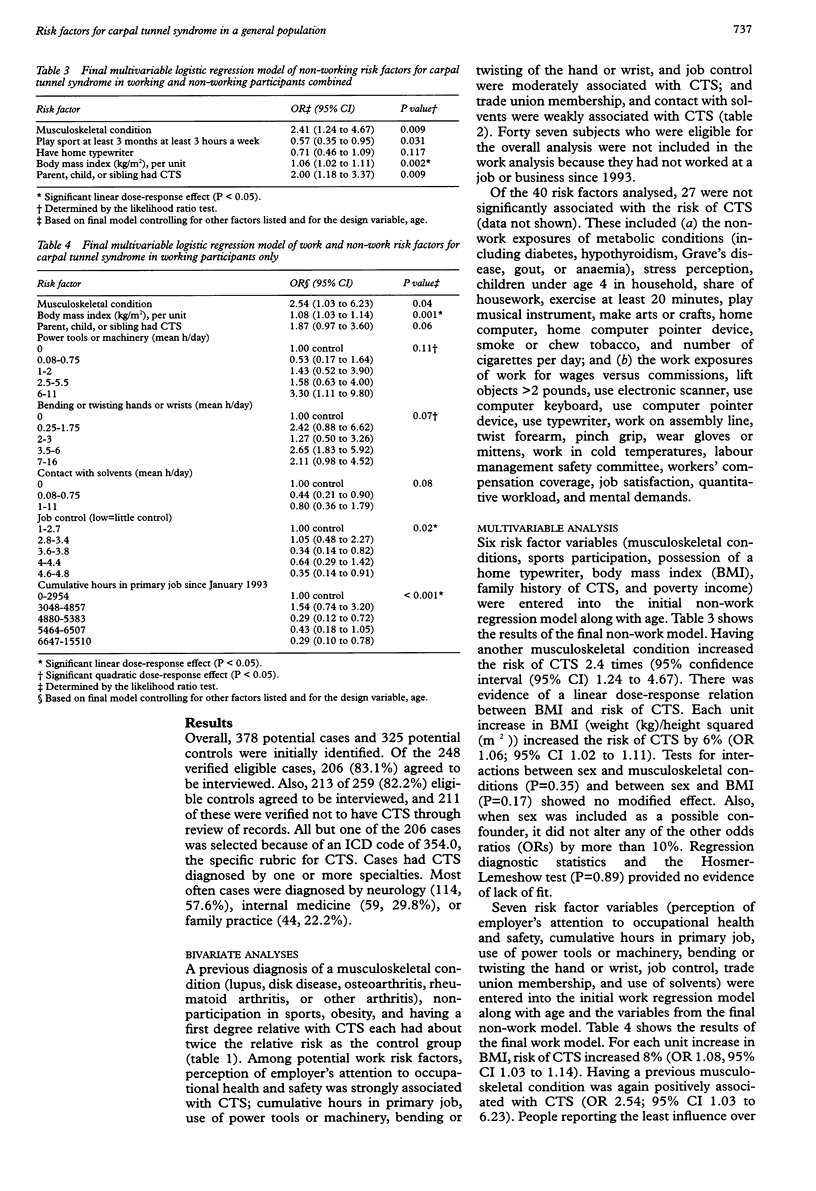

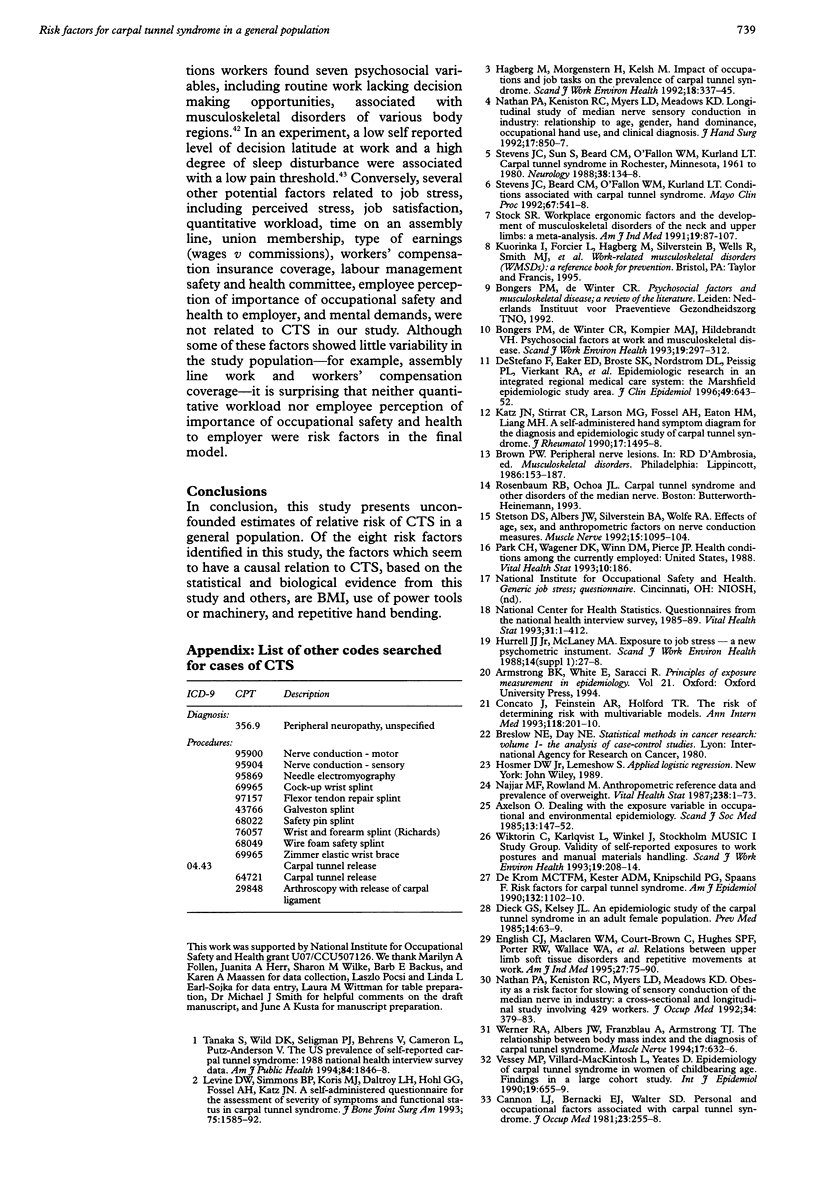
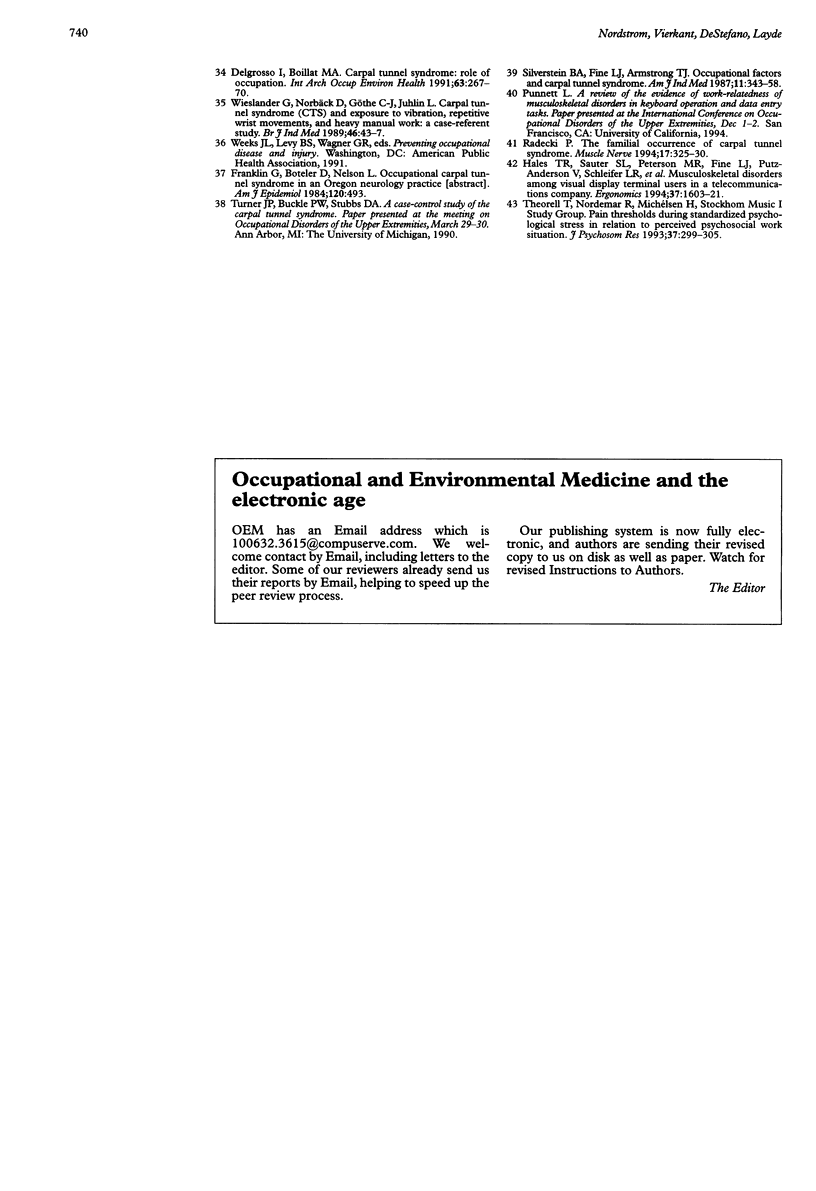
Selected References
These references are in PubMed. This may not be the complete list of references from this article.
- Axelson O. Dealing with the exposure variable in occupational and environmental epidemiology. Scand J Soc Med. 1985;13(4):147–152. doi: 10.1177/140349488501300404. [DOI] [PubMed] [Google Scholar]
- Bongers P. M., de Winter C. R., Kompier M. A., Hildebrandt V. H. Psychosocial factors at work and musculoskeletal disease. Scand J Work Environ Health. 1993 Oct;19(5):297–312. doi: 10.5271/sjweh.1470. [DOI] [PubMed] [Google Scholar]
- Cannon L. J., Bernacki E. J., Walter S. D. Personal and occupational factors associated with carpal tunnel syndrome. J Occup Med. 1981 Apr;23(4):255–258. [PubMed] [Google Scholar]
- Concato J., Feinstein A. R., Holford T. R. The risk of determining risk with multivariable models. Ann Intern Med. 1993 Feb 1;118(3):201–210. doi: 10.7326/0003-4819-118-3-199302010-00009. [DOI] [PubMed] [Google Scholar]
- DeStefano F., Eaker E. D., Broste S. K., Nordstrom D. L., Peissig P. L., Vierkant R. A., Konitzer K. A., Gruber R. L., Layde P. M. Epidemiologic research in an integrated regional medical care system: the Marshfield Epidemiologic Study Area. J Clin Epidemiol. 1996 Jun;49(6):643–652. doi: 10.1016/0895-4356(96)00008-x. [DOI] [PubMed] [Google Scholar]
- Delgrosso I., Boillat M. A. Carpal tunnel syndrome: role of occupation. Int Arch Occup Environ Health. 1991;63(4):267–270. doi: 10.1007/BF00386376. [DOI] [PubMed] [Google Scholar]
- Dieck G. S., Kelsey J. L. An epidemiologic study of the carpal tunnel syndrome in an adult female population. Prev Med. 1985 Jan;14(1):63–69. doi: 10.1016/0091-7435(85)90021-0. [DOI] [PubMed] [Google Scholar]
- English C. J., Maclaren W. M., Court-Brown C., Hughes S. P., Porter R. W., Wallace W. A., Graves R. J., Pethick A. J., Soutar C. A. Relations between upper limb soft tissue disorders and repetitive movements at work. Am J Ind Med. 1995 Jan;27(1):75–90. doi: 10.1002/ajim.4700270108. [DOI] [PubMed] [Google Scholar]
- Hagberg M., Morgenstern H., Kelsh M. Impact of occupations and job tasks on the prevalence of carpal tunnel syndrome. Scand J Work Environ Health. 1992 Dec;18(6):337–345. doi: 10.5271/sjweh.1564. [DOI] [PubMed] [Google Scholar]
- Hales T. R., Sauter S. L., Peterson M. R., Fine L. J., Putz-Anderson V., Schleifer L. R., Ochs T. T., Bernard B. P. Musculoskeletal disorders among visual display terminal users in a telecommunications company. Ergonomics. 1994 Oct;37(10):1603–1621. doi: 10.1080/00140139408964940. [DOI] [PubMed] [Google Scholar]
- Hurrell J. J., Jr, McLaney M. A. Exposure to job stress--a new psychometric instrument. Scand J Work Environ Health. 1988;14 (Suppl 1):27–28. [PubMed] [Google Scholar]
- Katz J. N., Stirrat C. R., Larson M. G., Fossel A. H., Eaton H. M., Liang M. H. A self-administered hand symptom diagram for the diagnosis and epidemiologic study of carpal tunnel syndrome. J Rheumatol. 1990 Nov;17(11):1495–1498. [PubMed] [Google Scholar]
- Levine D. W., Simmons B. P., Koris M. J., Daltroy L. H., Hohl G. G., Fossel A. H., Katz J. N. A self-administered questionnaire for the assessment of severity of symptoms and functional status in carpal tunnel syndrome. J Bone Joint Surg Am. 1993 Nov;75(11):1585–1592. doi: 10.2106/00004623-199311000-00002. [DOI] [PubMed] [Google Scholar]
- Najjar M. F., Rowland M. Anthropometric reference data and prevalence of overweight, United States, 1976-80. Vital Health Stat 11. 1987 Oct;(238):1–73. [PubMed] [Google Scholar]
- Nathan P. A., Keniston R. C., Myers L. D., Meadows K. D. Longitudinal study of median nerve sensory conduction in industry: relationship to age, gender, hand dominance, occupational hand use, and clinical diagnosis. J Hand Surg Am. 1992 Sep;17(5):850–857. doi: 10.1016/0363-5023(92)90455-x. [DOI] [PubMed] [Google Scholar]
- Nathan P. A., Keniston R. C., Myers L. D., Meadows K. D. Obesity as a risk factor for slowing of sensory conduction of the median nerve in industry. A cross-sectional and longitudinal study involving 429 workers. J Occup Med. 1992 Apr;34(4):379–383. [PubMed] [Google Scholar]
- Radecki P. The familial occurrence of carpal tunnel syndrome. Muscle Nerve. 1994 Mar;17(3):325–330. doi: 10.1002/mus.880170311. [DOI] [PubMed] [Google Scholar]
- Silverstein B. A., Fine L. J., Armstrong T. J. Occupational factors and carpal tunnel syndrome. Am J Ind Med. 1987;11(3):343–358. doi: 10.1002/ajim.4700110310. [DOI] [PubMed] [Google Scholar]
- Stetson D. S., Albers J. W., Silverstein B. A., Wolfe R. A. Effects of age, sex, and anthropometric factors on nerve conduction measures. Muscle Nerve. 1992 Oct;15(10):1095–1104. doi: 10.1002/mus.880151007. [DOI] [PubMed] [Google Scholar]
- Stevens J. C., Beard C. M., O'Fallon W. M., Kurland L. T. Conditions associated with carpal tunnel syndrome. Mayo Clin Proc. 1992 Jun;67(6):541–548. doi: 10.1016/s0025-6196(12)60461-3. [DOI] [PubMed] [Google Scholar]
- Stevens J. C., Sun S., Beard C. M., O'Fallon W. M., Kurland L. T. Carpal tunnel syndrome in Rochester, Minnesota, 1961 to 1980. Neurology. 1988 Jan;38(1):134–138. doi: 10.1212/wnl.38.1.134. [DOI] [PubMed] [Google Scholar]
- Stock S. R. Workplace ergonomic factors and the development of musculoskeletal disorders of the neck and upper limbs: a meta-analysis. Am J Ind Med. 1991;19(1):87–107. doi: 10.1002/ajim.4700190111. [DOI] [PubMed] [Google Scholar]
- Tanaka S., Wild D. K., Seligman P. J., Behrens V., Cameron L., Putz-Anderson V. The US prevalence of self-reported carpal tunnel syndrome: 1988 National Health Interview Survey data. Am J Public Health. 1994 Nov;84(11):1846–1848. doi: 10.2105/ajph.84.11.1846. [DOI] [PMC free article] [PubMed] [Google Scholar]
- Theorell T., Nordemar R., Michélsen H. Pain thresholds during standardized psychological stress in relation to perceived psychosocial work situation. Stockholm Music I Study Group. J Psychosom Res. 1993 Apr;37(3):299–305. doi: 10.1016/0022-3999(93)90039-i. [DOI] [PubMed] [Google Scholar]
- Vessey M. P., Villard-Mackintosh L., Yeates D. Epidemiology of carpal tunnel syndrome in women of childbearing age. Findings in a large cohort study. Int J Epidemiol. 1990 Sep;19(3):655–659. doi: 10.1093/ije/19.3.655. [DOI] [PubMed] [Google Scholar]
- Werner R. A., Albers J. W., Franzblau A., Armstrong T. J. The relationship between body mass index and the diagnosis of carpal tunnel syndrome. Muscle Nerve. 1994 Jun;17(6):632–636. doi: 10.1002/mus.880170610. [DOI] [PubMed] [Google Scholar]
- Wieslander G., Norbäck D., Göthe C. J., Juhlin L. Carpal tunnel syndrome (CTS) and exposure to vibration, repetitive wrist movements, and heavy manual work: a case-referent study. Br J Ind Med. 1989 Jan;46(1):43–47. doi: 10.1136/oem.46.1.43. [DOI] [PMC free article] [PubMed] [Google Scholar]
- Wiktorin C., Karlqvist L., Winkel J. Validity of self-reported exposures to work postures and manual materials handling. Stockholm MUSIC I Study Group. Scand J Work Environ Health. 1993 Jun;19(3):208–214. doi: 10.5271/sjweh.1481. [DOI] [PubMed] [Google Scholar]
- de Krom M. C., Kester A. D., Knipschild P. G., Spaans F. Risk factors for carpal tunnel syndrome. Am J Epidemiol. 1990 Dec;132(6):1102–1110. doi: 10.1093/oxfordjournals.aje.a115753. [DOI] [PubMed] [Google Scholar]


